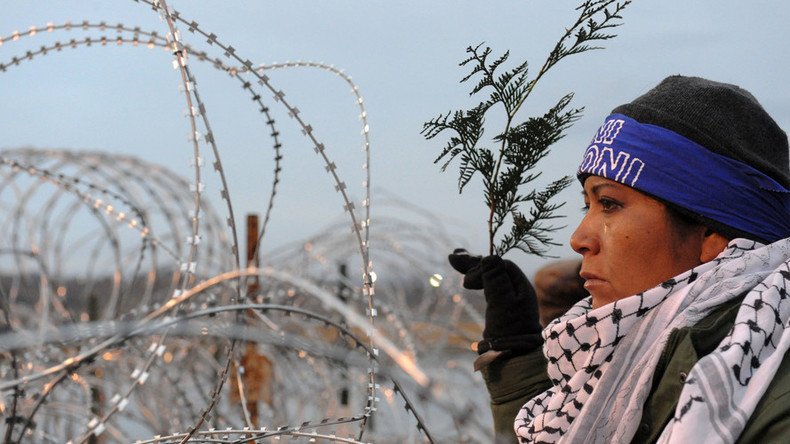‘Excessive military-style force’ used against DAPL protesters, says US Commission on Civil Rights

The US Commission on Civil Rights has suspected “disproportionate” use of excessive force and “military-style” equipment by police against the Dakota Access Pipeline protests. The activists have also filed a lawsuit, alleging illegal use of “highly dangerous weaponry.”
The Commission has also called for officials to deescalate tensions and guarantee safety of protesters exercising their First Amendment Rights.
Those demonstrating against the pipeline’s proposed route under a river less than a mile from the Standing Rock Reservation in North Dakota have been attacked by dogs, seriously injured by rubber bullets and exposed to water cannons in freezing temperatures by law enforcement.
Tribal elder hospitalized after suffering cardiac arrest in #DAPL clashes https://t.co/HDe8BULNOFpic.twitter.com/XQzahpcxyY
— RT America (@RT_America) November 21, 2016
The Commission’s statement begins with a reminder that November is Native American Heritage Month and that the protest “have highlighted the intersection of numerous issues the Commission has investigated recently, including the excessive use of force by police, the civil and sovereign rights of Native Americans, and environmental justice.”
The Commission expressed concern over reports of “military-style equipment and excessive force” being used against Native American protesters, “who are more likely than any other racial group to be killed by police.”
“Protesters have a constitutional right to peacefully assemble and lawfully express their concerns about the environmental and cultural impacts of the pipeline,” it said. “We call upon federal, state, and local officials and law enforcement to work together to deescalate the situation and guarantee the safety of protesters to exercise their First Amendment rights.”
Possible conflict of interest: #Trump owns shares in #DakotaAccessPipeline parent company https://t.co/hhdm8eFW5Cpic.twitter.com/A1BQdsSRIT
— RT America (@RT_America) November 25, 2016
On Monday, several protesters filed a class action lawsuit against Morton County and law enforcement agencies, who they accuse of “illegal use of force,” including “highly dangerous weaponry,” on the night of November 20 and early morning of November 21.
Protesters behind the lawsuit are seeking “an immediate court order to prohibit the unlawful use of excessive force.”
Nine activists, including five Native Americans, have also filed a mass-action complaint, in which they are seeking “compensatory, general and special damages” after sustaining injuries.
One of the activists, Vanessa Dundon of the Navajo Nation, was hit in the eye with a tear gas canister, shot by police. Another water protector, Jade Kalikolehuaokakalani Wool, had her face burned after two grenades blew up near her head. He had to be hospitalized. Crystal Wilson was shot with a water cannon, tear gassed and shot with a munition. An activist who was filming police was hit from a water cannon and then in the hand with a munition, which resulted in several bone fractures.
“No orders to disperse, or warnings were given before deployment of these high levels of force against the unarmed water protectors. On this night, over 200 water protectors, including Plaintiffs, were injured by excessive police force, some of them very seriously,” the group said.
Demonstrators are concerned the pipeline would threaten the water source of the Standing Rock Sioux tribe. The company behind the oil pipeline, Energy Transfer Partner, has seen its pipelines leak at least 18,845 barrels of oil since 2005 and has been fined over $22 million by the US government for environmental and other violations since 2010.
“The pipeline also poses a threat to the water supply of the Standing Rock Sioux, which raises issues of environmental justice and the lack of power of marginalized communities to have a say in the environmental health of their communities,” the statement continued.
It highlighted a preliminary Environmental Assessment of the pipeline by US Army Corps of Engineers which determined a pipeline route near Bismarck, which the Commission points out is a largely white area, was not viable because of its “proximity to municipal water supply lines.”
Hundreds of protesters #march through DC against #DAPLhttps://t.co/JwcOpLn4Lzpic.twitter.com/YoO66n9FH3#Dakota#pipeline#protest
— RT America (@RT_America) November 27, 2016
The same engineers found no issues with routing the pipeline beside the Standing Rock reservation, for which the Environmental Protection Agency, Department of Interior, and Advisory Council on Historic Preservation criticized them for, the Commission pointed out.
“State and local government receive the economic and tax benefits from infrastructure development, while Tribes are left with the environmental impact and little resources to monitor and respond to environmental risks,” it said.
The Commission said it was “encouraged” by the Army Corps announcing last week it would carry out additional analysis, and called for a full Environmental Impact Study of the pipeline.
Army Corps will close anti-DAPL protest camp at Standing Rock by Dec. 5 https://t.co/iZjS5TeSkvpic.twitter.com/YRMdMzVRaZ
— RT America (@RT_America) November 25, 2016
On Friday, however, the US Army Corps of Engineers said it would close public access to their land where the Oceti Sakowin Camp is set up on December 5, meaning protestors would be on unauthorized land. Although the Army Corps said it was not planning to forcibly remove anyone, those who stay on the land would be at risk of being arrested.
“The issue of the pipeline is not just about the pipeline alone, but rather it is about the entire relationship between the United States and sovereign Indian Nations, their rights, traditions and religious beliefs,” Commission chair Martin Castro said.
“As we prepare our civil rights report on this relationship we call on Congress to make it a priority to address the problems in Indian country by holding its own hearings to hear from Native leaders about the unmet needs and unmet promises owed to Native Americans by the United States of America.”
The Commission pointed to previous reports highlighting “significant shortcomings” in tribal community funding, which damages the health and welfare of the Native communities.












